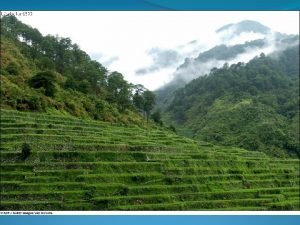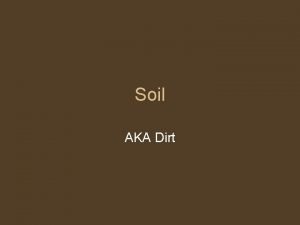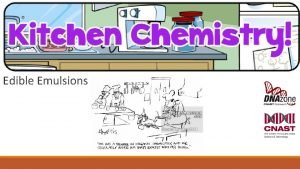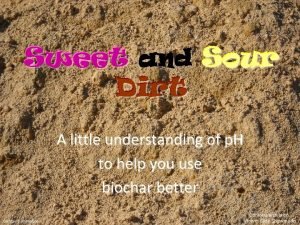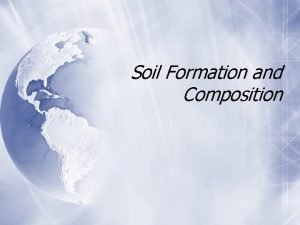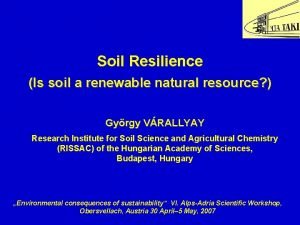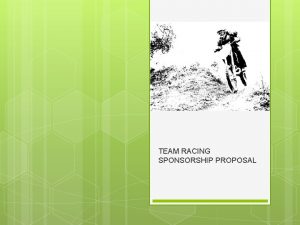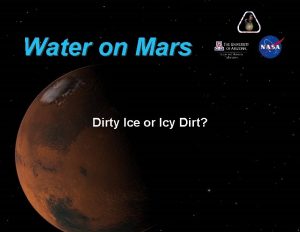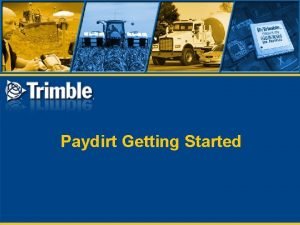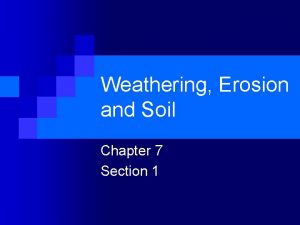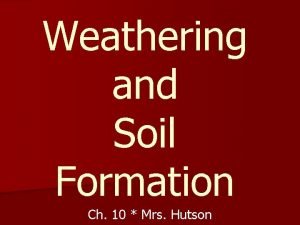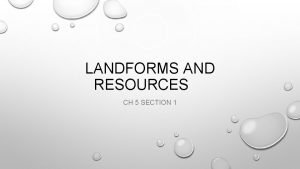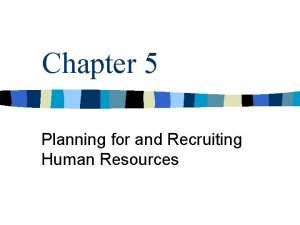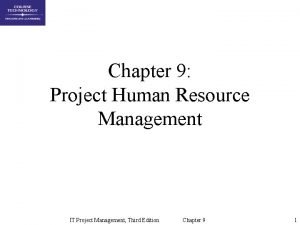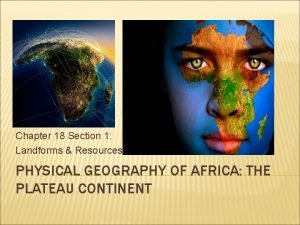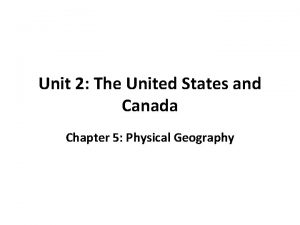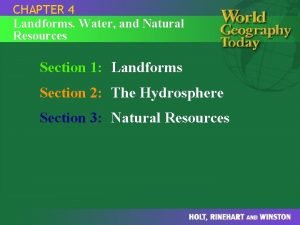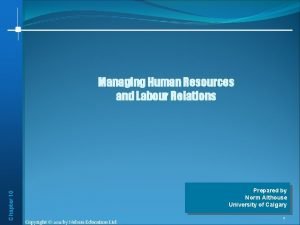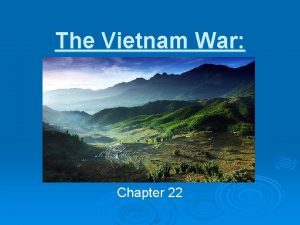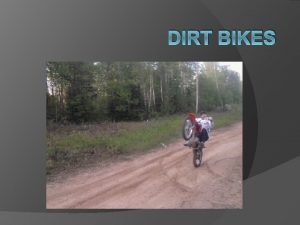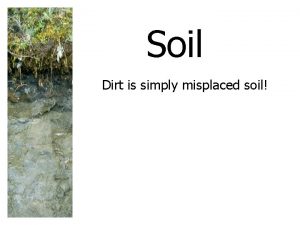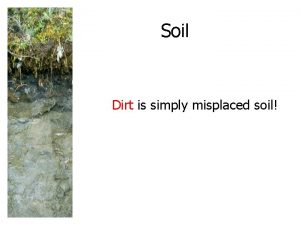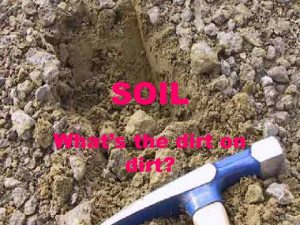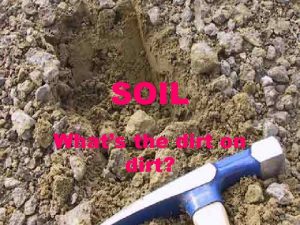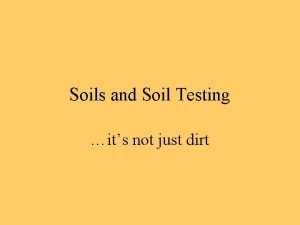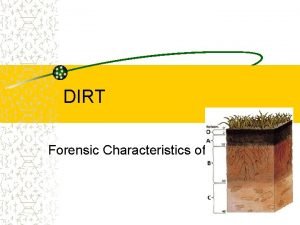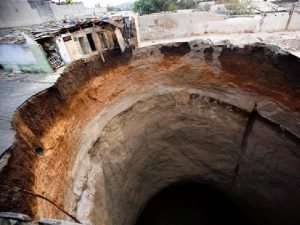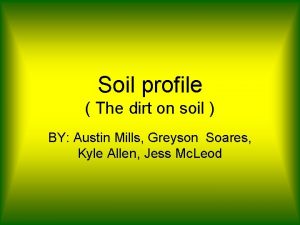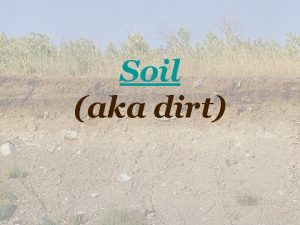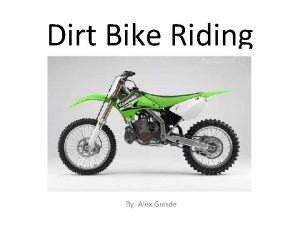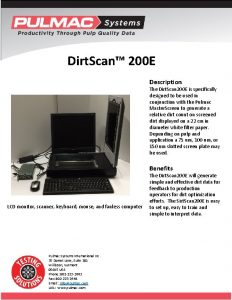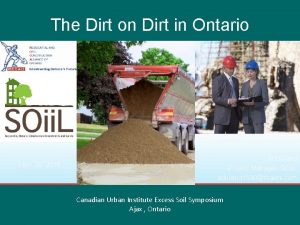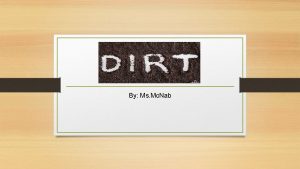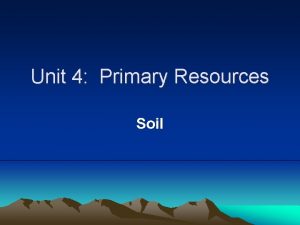Chapter 11 Soil Resources its just dirt I





















































- Slides: 53

Chapter 11 - Soil Resources it’s just dirt!

I. Soils: Products of Weathering A. Soil loose surface materials composed of weathered rock and mineral materials with variable amounts of organic matter • can support growth of plants • resting upon bedrock


Soils B. Residual vs. Transported Soils • Residual formed “in situ” via weathering • Transported formed elsewhere & deposited alluvial, glacial, wind deposited Example loess soils & the Palouse


Soils C. Soil Profile vertical section of soil from surface to bedrock D. Soil Horizons layers of soil (in profile) distinguished by color, texture, structure & composition

Soil Profile & Horizons


Soils E. Color & Texture 1. Color indications of composition • Higher organics darker color • Higher iron redder color • Higher calcium or salts whitish colors


Soils 2. Texture • Grain sizes Sand, silt, clay • often determines physical properties -looseness/compactibility -drainage & moisture retention

Soil Texture

Soils F. Soil Classification “a pain in the _____!” • Early attempts Zonal classification based on climate controls, temp. vs. rainfall

Classification • “modern” classification soil science vs. engineering classification • Classified by physical characteristics • 14, 000 soil “series” now recognized! • Forgetaboutit!


II. Soil Resources & Problems Soil a renewable resource? A. Soil Erosion • U. S. farmlands, 1992 = 2 billion tons • ~4. 8 tons/acre, average annual loss • ~1. 6 tons/acre, avg. annual formed • accumulated side effects!

Soil Erosion Styles of erosion • Sheet • Rill • Gullying • Wind





Global Soil Erosion

II. Soil Resources & Erosion B. Causes 1. Natural 2. Human-related • Overgrazing & bad agriculture techniques • Deforestation • Recreational activities




Case Study: Palouse soil erosion • Palouse region, eastern WA Go COUGS! • Loess soil wind blown silt

Case Study: Palouse soil erosion • Formed during Pleistocene glaciation • Several hundred feet thick in places • High fertility, important physical properties & agricultural potential • Interesting historical ramifications

Palouse soil & erosion issues

Palouse soil erosion • Up to 25 tons/acre/year erosion • Highest rates 200 tons/acre/year! steeper slopes • ~. 17 inches/year 8. 5 inches/50 years *Farm near Thornton, WA 4. 5 feet of soil lost in less than 50 years!

Palouse soil erosion • 20% + of cropland eroded to subsoils • Decreased yields • Increased fertilizers needed, decreased soil p. H (acidifying) Dirt: The Erosion of Civilizations, Civilizations 2007, David Montgomery, University of California Press

Palouse soil erosion Contributing factors to Palouse erosion? • Intensive mechanized farming tractor plowing began (1930’s) • Plowing on hillsides • Rain on freshly plowed land rilling/gullying • Wind storms age-dated lake cores 4 -fold increase in erosion w/modern plowing

II. Soil Resources B. Soil Contamination • Industrial pollution • Salinization

II. Soil Resources & Problems C. Expansive Soils • expansion upon water saturation • shrink when dried out • $6 billion/year damages • Clay-rich soils Why is clay the culprit?



Expansive Soils Mitigation • How to deal with expansive soils? • Hire a geoengineering firm & spend lots of $$$$ fixing the problem after, or…. . • Spend less $$$$$ before • http: //web. mst. edu/~rogersda/umrcourses/g e 341/


II. Soil Resources & Problems D. Settlement • Non-uniform settling and compaction • Differential settlement • Soils with strength & cohesion differences READ Leaning Tower of Pisa

II. Soil Resources & Problems E. Permafrost • Permanently frozen ground • Northerly, polar latitudes • Freezing depth (winter) exceeds thaw depth (summer)



Case Study: The Trans-Alaska Pipeline A. Prudhoe Bay (North Slope) oil fields • Discovered 1968 – “world class field” • Remote location, cold water port • No oil tankers! How to get the oil to market? • 1300 km (~800 mi) pipeline

Trans Alaskan Pipeline B. Pipeline Route • Prudhoe Bay to Valdez (Prince William Sound) • Inaccessible wilderness • 2 mountain ranges, large river crossings • LARGE areas of permafrost

Trans Alaskan Pipeline C. Planning Studies, Designs, & Cost • Prefeasibility studies mapping & drilling bedrock vs. permafrost • Identified faults active Denali fault • Permafrost dilemma oil needs to flow @ 65 o. C in 48” pipeline *1/2 of pipeline must be above ground why?

Trans Alaskan Pipeline Above ground design MUST: • Dissipate heat away from ground • Allow for fault movements & earthquakes • Vertical support members (down to 60’) w/heat exchangers & refrigerant • Horizontal beam & jiggle joints for magnitude 8 quake

Building on permafrost




2002 Denali Fault Earthquake • 7. 9 magnitude • Remote section on Denali fault • Movement along fault ~14 feet! • Design specifications withstand quake!


 Living soil vs dead soil
Living soil vs dead soil What are the four spheres of the earth
What are the four spheres of the earth Who is present when juliet awakens
Who is present when juliet awakens Porosity of soil
Porosity of soil A nation that destroys its soil destroys itself
A nation that destroys its soil destroys itself Soil located above its parent material
Soil located above its parent material Difference between transforming and transformed resources
Difference between transforming and transformed resources Fixed resources
Fixed resources Renewable vs nonrenewable resources worksheet
Renewable vs nonrenewable resources worksheet Vray edges texture
Vray edges texture Soil texture importance
Soil texture importance How does soap remove dirt
How does soap remove dirt Sour dirt
Sour dirt Is dirt biotic or abiotic
Is dirt biotic or abiotic Is a flower abiotic or biotic
Is a flower abiotic or biotic Is soil renewable
Is soil renewable Fitt acronym
Fitt acronym What did dill dare jem to do?
What did dill dare jem to do? Drag racing sponsorship packages
Drag racing sponsorship packages Alliteration in songs
Alliteration in songs The dirt
The dirt Icy dirt
Icy dirt Dirt bioe
Dirt bioe Paydirt software
Paydirt software Never_used
Never_used The emigree key themes
The emigree key themes When a train increases its velocity, its momentum
When a train increases its velocity, its momentum Rainy sunny cloudy windy
Rainy sunny cloudy windy If its square its a sonnet summary
If its square its a sonnet summary Its halloween its halloween the moon is full and bright
Its halloween its halloween the moon is full and bright Its not easy but its worth it
Its not easy but its worth it Chapter 7 weathering erosion and soil
Chapter 7 weathering erosion and soil Chapter 10 weathering and soil formation answers
Chapter 10 weathering and soil formation answers Chapter 24 section 1 landforms and resources
Chapter 24 section 1 landforms and resources Chapter 21 section 1 landforms and resources
Chapter 21 section 1 landforms and resources Chapter 5 section 1 landforms and resources answer key
Chapter 5 section 1 landforms and resources answer key Chapter 9 human resource management
Chapter 9 human resource management Chapter 8 study guide human resources culture and diversity
Chapter 8 study guide human resources culture and diversity Chapter 8 human resources culture and diversity
Chapter 8 human resources culture and diversity Chapter 5 personnel planning and recruiting
Chapter 5 personnel planning and recruiting Chapter 27 section 1 landforms and resources
Chapter 27 section 1 landforms and resources Chapter 27 human impact on earth resources
Chapter 27 human impact on earth resources Chapter 14 water resources answer key
Chapter 14 water resources answer key Chapter 13 mineral resources and mining
Chapter 13 mineral resources and mining Chapter 11 section 1: water resources answers
Chapter 11 section 1: water resources answers Human resources management chapter 1
Human resources management chapter 1 Chapter 9 human resources management
Chapter 9 human resources management Chapter 18 section 1 landforms and resources
Chapter 18 section 1 landforms and resources Chapter 12 nonrenewable energy resources
Chapter 12 nonrenewable energy resources Unit 2 the united states and canada worksheet answers
Unit 2 the united states and canada worksheet answers Natural resources from landforms
Natural resources from landforms Chapter 10 managing human resources
Chapter 10 managing human resources Chapter 2: economic systems worksheet answer key
Chapter 2: economic systems worksheet answer key Whats vietnamization
Whats vietnamization




